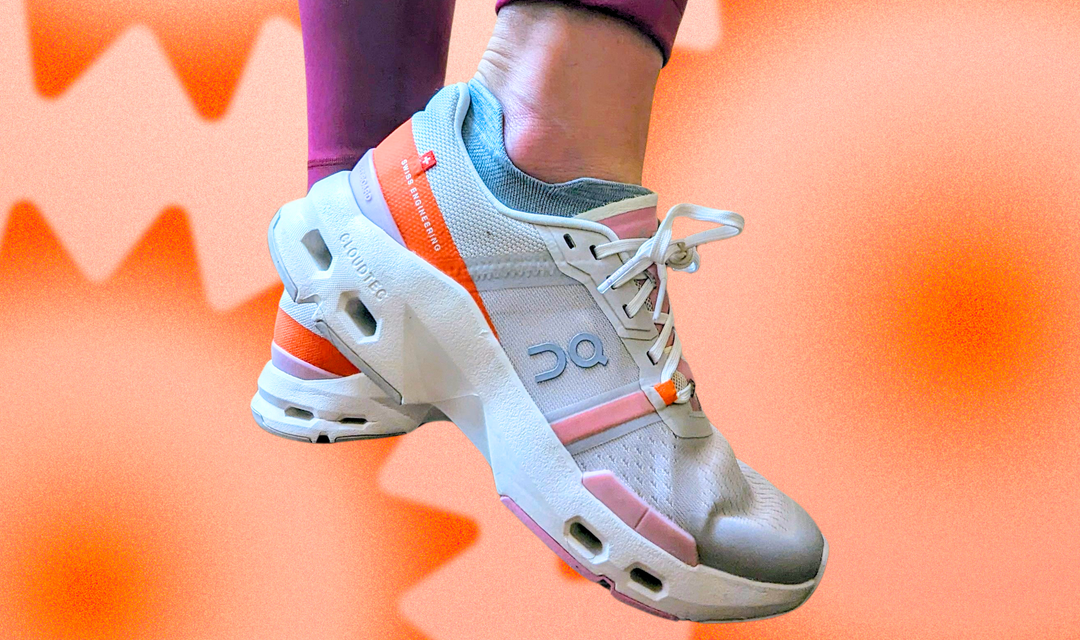I wouldn’t say these shoes felt marshmallowy soft, like you’d expect with max-cushioned running shoes. But they also didn’t feel like weightlifting shoes either—those tend to be stiffer, flatter to the ground, and generally not something you’d want to spend lots of time in when you’re not strength training. I’d consider the Cloudpulses comfy, but not really to the point where I’d call it out. Rather, they were more like, put them on, lace them up, and forget that they’re on—which isn’t really a bad feature in a shoe!
On the activity
I wore the Cloudpulse during three different gym sessions—two of which included some elliptical time—and a one-mile walk over the course of a week. I started my workouts with a quick mile on the elliptical to warm up, and I loved that I was able to do this: Easy cardio helps my muscles feel more pliable for lifting heavier weights, but I usually don’t do it because the stiff-bottomed weightlifting shoes I wear don’t feel great during all that repetitive motion. The Cloudpulse, on the other hand, felt more flexible and cushioned, so the 10 minutes flew by. (I enjoyed them so much during the cardio that I wore them for a weekday walk, and they felt comfy then too.)
These shoes also have an eight-millimeter heel drop (the difference in height of the foam between the heel and the toe), so they’re not flat to the floor like traditional weightlifting shoes nor are they quite as high-drop as some maximalist running shoes. As a result, I felt more grounded while doing heavy lower-body exercises like barbell deadlifts, split squats, sumo squats, and good mornings than I would if I wore running shoes, but not as dialed in as I would with flat lifting shoes. When doing dynamic moves, like barbell reverse lunges, I appreciated the flexibility of the Cloudpulse, which allowed me to dig my toe into the floor.
The Cloudpulse really shined during dynamic exercises that had me moving in all sorts of directions, rather than simply back and forth or up and down. These shoes had really nice side-to-side stability, which was key for lateral step-ups and lunges, and some pop for HIIT-based, explosive moves. They felt especially great during skater hops, where you need both the stability to keep your foot in line when you leap to the side, and energy return to get the most out of your jumps.
Bottom line
The Cloudpulse is a comfy cross-training gym shoe—and you don’t feel the need to kick them off right after because they’re cushioned, supportive, and cute enough to wear during the rest of your day too. They’re a solid option for a workout that has you doing a little of a lot, when you need a not-too-specialized shoe that can take you through each part of it.
In particular, if you’re big on fitness classes like bootcamps or program your own workouts in HIIT-based circuits, these might be a great choice for you. When you’re doing exercises that have you jumping (say, box jumps, skater hops, or burpees), moving laterally (like curtsy lunges or monster walks), or even just cranking out a lot of reps for time, you need a shoe that keeps you steady when you move but with enough cushion to keep your joints happy.
If you’re into lifting heavy weights and looking to build max strength, these shoes don’t offer quite the connection with the floor that really allows you to push through it (though they are better than typical running shoes). I didn’t have any issues doing heavy upper-body moves (like the overhead press), where you still need a solid foundation. But I did notice that my toes would lift off the floor doing good mornings, and I didn’t feel as secure as I’d like when doing heavy barbell deadlifts. For workouts that are all about lower-body max strength, you probably need a shoe that’s a little stiffer and flatter—but if you’re doing other things too, you can simply kick them off during the heavy stuff and enjoy the comfort of the Cloudpulse for everything else.

